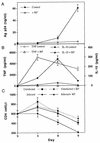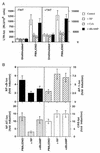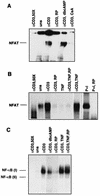Inhibition of phosphodiesterase type IV suppresses human immunodeficiency virus type 1 replication and cytokine production in primary T cells: involvement of NF-kappaB and NFAT
- PMID: 9573235
- PMCID: PMC109998
- DOI: 10.1128/JVI.72.6.4712-4720.1998
Inhibition of phosphodiesterase type IV suppresses human immunodeficiency virus type 1 replication and cytokine production in primary T cells: involvement of NF-kappaB and NFAT
Abstract
Rolipram, a phosphosdiesterase type IV-specific inhibitor, prevented p24 antigen release from anti-CD3-activated human immunodeficiency virus (HIV)-infected T cells and CD4(+)-cell depletion associated with viral replication in a dose-responsive manner but minimally inhibited T-cell proliferation. Moreover, rolipram reduced the production of tumor necrosis factor alpha (TNF-alpha) and interleukin-10 (IL-10) by HIV-infected T cells. The transcriptional ability of a luciferase reporter gene under control of the HIV long terminal repeat, induced by phorbol myristic acetate plus ionomycin or by TNF-alpha, in primary T and Jurkat cells was also inhibited by rolipram. Rolipram inhibited NF-kappaB and NFAT activation induced by T-cell activation in Jurkat and primary T cells, as measured by transient transfection of reporter genes and electrophoretic mobility shift assays. Exogenous addition of TNF-alpha in the presence of rolipram restored NF-kappaB but not NFAT activation or p24 release. Addition of dibutyryl-cyclic AMP (dBcAMP) mimicked the effects of rolipram on p24 antigen release, NF-kappaB activation, and TNF-alpha secretion, but it did not affect NFAT activation or IL-10 production. The protein kinase A inhibitor KT5720 prevented the inhibition of TNF-alpha secretion but not that of HIV type 1 (HIV-1) replication caused by rolipram. Our data indicate that blockade of phosphodiesterase type IV could be of benefit against HIV-1 disease by modulating cytokine secretion and transcriptional regulation of HIV replication, and they suggest an important role of NFAT in HIV replication in primary T cells. Some of those activities cannot be ascribed solely to its ability to increase cAMP.
Figures








References
-
- Alcami J, Lain de Lera T, Folgueira L, Pedraza M A, Jacque J-M, Bachelerie F, Noriega A R, Hay R T, Harrich D, Gaynor R B, Virelizier J-L, Arenzana-Seisdedos F. Absolute dependence on κB responsive elements for initiation and Tat-mediated amplification of HIV transcription in blood CD4 T lymphocytes. EMBO J. 1995;14:1552–1560. - PMC - PubMed
-
- Angel J B, Saget B M, Walsh S P, Greten T F, Dinarello C A, Skolnik P R, Endres S. Rolipram, a specific type IV phosphodiesterase inhibitor, is a potent inhibitor of HIV-1 replication. AIDS. 1995;9:1137–1144. - PubMed
-
- Angel J B, Saget B M, Wang M Z, Wang A, Dinarello C A, Skolnik P R. Interleukin-10 enhances human immunodeficiency virus type 1 expression in a chronically infected promonocytic cell line (U1) by a tumor necrosis factor α-independent mechanism. J Interferon Cytokine Res. 1995;15:575–584. - PubMed
-
- Antoni B A, Stein S B, Rabson A B. Regulation of human immunodeficiency virus infection: implications for pathogenesis. Adv Virus Res. 1994;43:53–145. - PubMed
Publication types
MeSH terms
Substances
LinkOut - more resources
Full Text Sources
Other Literature Sources
Research Materials

